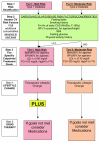Dyslipidemia in youth with diabetes: to treat or not to treat?
- PMID: 18847618
- PMCID: PMC2585025
- DOI: 10.1016/j.jpeds.2008.05.062
Dyslipidemia in youth with diabetes: to treat or not to treat?
Figures



Comment in
-
Relation between low-density lipoprotein particle size and insulin and diabetes mellitus.J Pediatr. 2009 Oct;155(4):600. doi: 10.1016/j.jpeds.2009.05.036. J Pediatr. 2009. PMID: 19773013 No abstract available.
References
-
- Liese AD, D'Agostino RB, Jr., Hamman RF, Kilgo PD, Lawrence JM, Liu LL, et al. The burden of diabetes mellitus among US youth: prevalence estimates from the SEARCH for Diabetes in Youth Study. Peds. 2006;118:1510–1518. - PubMed
-
- EURODIAB ACE Study Group Variation and trends in incidence of childhood diabetes in Europe. Lancet. 2000;355:873–876. - PubMed
-
- Pinhas-Hamiel O, Zeitler P. The global spread of type 2 diabetes mellitus in children and adolescents. J Pediatr. 2005;146:693–700. - PubMed
-
- Vehik K, Hamman RF, Lezotte D, Norris JM, Klingensmith G, Bloch C, et al. Increasing incidence of type 1 diabetes in 0- to 17-year-old Colorado youth. Diab Care. 2007;30:503–509. - PubMed
-
- Pavkov ME, Bennett PH, Knowler WC, Krakoff J, Sievers ML, Nelson RG. Effect of youth-onset type 2 diabetes mellitus on incidence of end-stage renal disease and mortality in young and middle-aged Pima Indians. JAMA. 2006;296:421–426. - PubMed
Publication types
MeSH terms
Substances
Grants and funding
LinkOut - more resources
Full Text Sources
Medical

